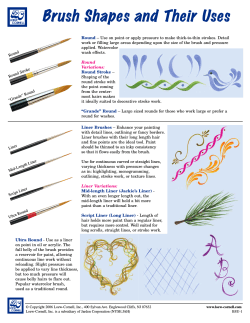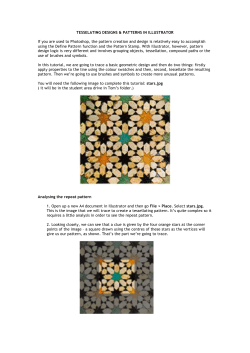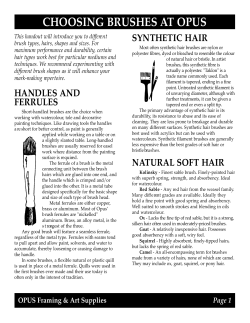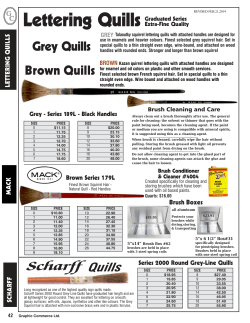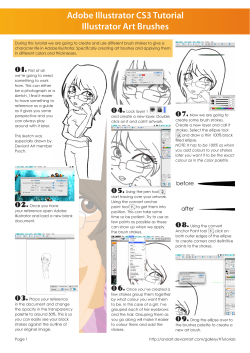
d How to Evaluate a Paintbrush DuPont Filaments Technical Information
Technical Information d DuPont Filaments How to Evaluate a Paintbrush Copyright © 1999 E.I. du Pont de Nemours and Company. All rights reserved. Contents Page Brush Styles . . . . . . . . . . . . . . . . . . . . . . . . . . . . . . . . . . . . . . . . . . . . . . . . . . . 1 Filament Mixtures . . . . . . . . . . . . . . . . . . . . . . . . . . . . . . . . . . . . . . . . . . . . . . 2 Brush Head Finishing . . . . . . . . . . . . . . . . . . . . . . . . . . . . . . . . . . . . . . . . . . . . 4 Handle Styles . . . . . . . . . . . . . . . . . . . . . . . . . . . . . . . . . . . . . . . . . . . . . . . . . . 4 Components of a Brush . . . . . . . . . . . . . . . . . . . . . . . . . . . . . . . . . . . . . . . . . . 5 Brush Stiffness . . . . . . . . . . . . . . . . . . . . . . . . . . . . . . . . . . . . . . . . . . . . . . . . . 6 Clean Up . . . . . . . . . . . . . . . . . . . . . . . . . . . . . . . . . . . . . . . . . . . . . . . . . . . . . . 8 How to Evaluate a Paintbrush Introduction Brush Styles Every brushmaker developing a brush for a new market is faced with the same question: Have I made a good brush? Brushes often have names related to the application for which they are best suited, i.e., sash brushes are used to paint window trim and wall brushes are used to paint walls. The brush designs are notably different (Figure 1). At one extreme, sash brushes are generally narrow, thin brushes with thin handles and precise filament trim cuts for accurate painting next to molding around a door or window. Angular sash brushes with the filaments trimmed at an angle offer greater accuracy and line control. At the other extreme are wall brushes which are usually wide, thick brushes with longer filaments and heavier handles to apply paint quickly over a large surface. The answer to this question varies with the market, paint, and geographic area where the brush will be sold. Painting styles and techniques vary from one place to another as do paints and the types of surfaces to be painted. Even though the final goal is different for every brushmaker, it is important to be able to evaluate paintbrushes equally. This brochure discusses brush appearance, key properties and performance characteristics so a brushmaker or painter can compare brushes and choose the right level of quality and performance needed for their application. Visual Examination Much can be learned about the probable performance of a brush by closely examining its construction before it reaches a paint can. A good place to start is a procedure developed by the American Society of Testing Materials (ASTM). Procedure D5301, “Standard Practice for Physical Characterization of Paint Brushes,” provides a basic understanding of key paintbrush elements. It is not meant to be an analytical tool to identify a perfect paintbrush, but it covers the dimensions, terminology, materials, and characteristics of paint brushes. Figure 2: Top of brush Brush performance is affected by the way that the filament tips are shaped. Brushes can be flat across the top, shaped to a dome or chiseled to a fine tip (Figure 2). Usually the filaments themselves are tipped and/or flagged (Figure 3). The amount and type of this “finishing” will affect the painting quality. Figure 1: Several different brushes Figure 3: Tipped and flagged filaments 1 Dimensions Next, determine the number of different filament lengths in a brush. This is usually done by bending the brush gently with the edge of your hand while moving your hand slowly from the ferrule towards the brush tip. Each separate filament length will snap back to a straight position as you move beyond its length. A brush with a greater variety of filament lengths will bend more gradually in response to increased brush pressure, allowing finer control while painting. This is not a guarantee of the number of different filaments used since special construction techniques can make the number of apparent filaments to be more than those actually used. The three brush dimensions that are most important to consider are: • width • thickness • trim length The width of the brush is the major dimension of the brush measured at the ferrule. The thickness of the brush is the minor dimension of the brush measured at the ferrule. The trim length is also known as the filament clear length. It is the length of the exposed filament from the top of the ferrule to the tip of the brush. The preferred brush trim length can vary from one region to another so do not assume that all brushes of the same width have the same trim length. For more detailed information about filaments in a brush, the brush must be disassembled and the filaments separated by length. For each length, the diameter of the filament should be measured at both ends. If the filament is uniform in dimension along its length, it is classified as “level” filament. Filaments which have a diameter that is larger at one end than the other are classified as “tapered” filaments (Figure 4). Often tapered filaments are further characterized by noting the ratio of the thick diameter to the thin diameter. This is commonly called the “taper ratio.” Standard synthetic tapered filaments are offered in ratios such as 15⁄10, 12⁄8, and 9 ⁄5 where the numbers reference the diameter in thousandths of an inch (mils). Level filaments are available in a wide variety of diameters. Higher quality brushes use 100% tapered filaments for gradual bending along the length of the filament. Painters in each country or region often have developed designs that they prefer. Do not expect that it will be easy to offer different designs and have them accepted without considerable promotional support. Filament Mixture Higher quality brushes will indicate the type of filament on the package label, or stamped on the handle. This information is a useful aid in choosing the right brush for the painting environment where it will be used. However, a more detailed analysis will yield better insight into the quality of the brush and probable performance before the brush hits the paint. The highest quality brushes contain either 100% tapered synthetic filaments or 100% high quality hog bristle. Lower quality brushes can contain mixtures of different filaments including level filaments, hollow filaments, lower quality animal bristle from hogs as well as horses, cows, etc. The objective in mixing in these filaments is usually to reduce cost, not to improve performance. d d Level filament: uniform diameter “d” For a more detailed analysis, examine the brush to determine the type of filament it contains. Hog bristle, usually black or white, can often be distinguished by its low gloss, flagged tip, and irregular surface along the length of the bristle. Synthetic filaments will appear to be more consistent and glossier but can have many shapes, colors, and tip treatments. An easy test to check for natural bristle is to place the brush filaments in a clear container holding water. Since natural bristle absorbs water quickly, the filaments will flair outwards from the ferrule. Also a new dry brush with natural bristle may smell like a preservative. When wet the brush may also smell like wet hair. D d tip butt Tapered filament: larger at butt than tip Figure 4: Level and tapered filaments The life of a brush will be affected by the type of filaments used as well as the shape of the filaments. As mentioned before, the highest quality filaments are solid-round-tapered synthetic filaments made from nylon type 612 or polyester PBT or high quality hog bristle. 2 However, brush cost can be reduced by using filaments made from cheaper polymers or filaments with lower density such as hollow or shaped filaments (Figure 5). Professional Grade Tynex® nylon-Orel® polyester filament mixture Professional Grade Tynex® SRT nylon filament mixture Some filaments have cross sectional shapes that reduce their bulk density. Quadrilobal or x-shaped filaments require less filament weight to fill a brush than a solid filament of the same diameter (Figure 7). Since they are not hollow, they retain their good flex properties and do not buckle or split. SRT SRT ® Chinex synthetic bristle mixture Consumer Grade Tynex® Q tapered nylon filament mixtures Consumer Grade Orel® T triocular tapered polyester filament-natural bristle mixture Figure 5: Shaped and hollow filaments Figure 7: Filament shapes Most hollow filaments are easy to detect simply by bending outwards 90 degrees from the ferrule. If they flex back to their original straight position, they are likely solid filaments. Most hollow filaments remain buckled or broken at the bend point (Figure 6). During repeated use or cleaning, hollow filaments can be easily damaged. Hollow filaments are used in brushes because of their lower cost per volume of filament. DuPont offers a durable hollow filament, OREL® T, that can withstand rigorous flexing. The three small hollow channels are supported by supporting ribs. This product offers weight reduction with good buckling resistance. Nylon tapered filaments have a 5–9 times greater resistance to abrasion than hog bristle and brushes made from these filaments will have a much longer life in all paint brush applications (Figure 8). DuPont Filaments offers technical information that outlines tests that can be performed to identify the polymer type of a synthetic brush filament. In some cases, a simple burn test is enough to distinguish between two common filaments, polyester and nylon. Each of these polymers has physical properties that affect the performance of a brush. A mixture of different synthetic filaments is often used in a brush to tailor the brush for its end use application. Figure 6: Broken filaments Figure 8: Two brushes showing wear 3 Brush Head Finishing Handle Style Look carefully at the brush head to assess the finishing quality. The top edge of the brush should have a uniformly straight edge. This is especially true not only for sash brushes that are used for accurate trim painting but also for larger brushes. Ragged edges make it difficult to lay down paint evenly and to paint in a straight line. There are many paintbrush handle styles, sizes, and quality levels. Handles are chosen to match the brush application and also differ by regional preference and painting technique. If a brush is intended for trim painting where accurate positioning and control of the brush is essential, a slender many-sided handle may be selected for easy control. Large wall brushes may use a heavier beavertail handle for comfort and for minimizing fatigue due to the heavier brush head. “Rattail” or pencil style handles are used on brushes with narrow or round/oval ferrules or brushes that can be rotated as they are used. If the filaments in the brush head tend to flare outward or create an opening when looking down at the tip of the brush (this is called fishmouth) (Figure 9), the most likely cause is an improperly positioned ferrule plug or plugs. Better brushes are intentionally shaped to taper gradually towards the tip for better brush control. This is done by careful design and positioning of the plugs and ferrule. Most quality brush handles are made of hardwood and sold natural without paint or lacquer, although handle coatings are common in some regions (Figure 10). Lower quality softwood handles are almost always coated. A new grade of high quality plastic handles offer some benefits such as durability but may not have the same “feel.” Inexpensive consumer brushes frequently have cheaper molded handles. Whatever the style, all handles should be smoothly finished, free of rough edges and splinters. Painted, lacquered, or natural finish is an individual preference. However, any colored finish or labeling should be durable enough that it does not chip or peel when in use or during cleaning. Figure 9: Fishmouth Examine the tips of all filament lengths in finer finishing brushes to see if the brush head filaments have been sanded to a pencil point tip, flagged into many fine tips, or a combination. The depth of the tipping will vary depending on the size of the brush but is typically between 1⁄4 and 1⁄2 inches. A high percentage of the filaments should be tipped. If the filaments are also flagged, only the longest will be flagged. Since it is more difficult to flag solid round filaments, typically 50% or more will be flagged. Look for broken filaments and burrs. These can be detected by gently massaging the filament ends. Sharp edges are readily evident and will likely cause drag lines in the painted surface. Sharp edges can be removed by sanding the filament tips during brush manufacturing. Figure 10: Handle styles 4 Filament Pullout Strength Handle Attachment Poor filament retention in the ferrule can cause a brush to shed filaments. The loose filaments are often deposited on the painted surface or left in the paint can. This is why all brushes, handmade or machine made, should be combed for loose filaments before packaging. When examining a brush, see if the filaments come loose when pulled gently by hand. The brush head can be attached to the handle by crimping, stapling, or nailing the ferrule to the handle. The most durable assembly uses ring nails that connect the ferrule, a ferrule insert, and the handle together (Figure 12). On thin handles, nails should be offset or staggered in a pattern that prevents nails from the two sides being directly opposite each other to minimize the chance of splitting the wood or plastic. Securing the filament in the brush head depends on epoxy type, mixture accuracy, filament shape, and polymer type. It is important to work closely with the adhesive supplier to match the epoxy to the filament and ferrule material being used. Most adhesive suppliers conduct pull tests using an Instron* tensile tester to measure the force needed to pull filaments out of the adhesive (Figure 11). These suppliers develop epoxy mixtures that work best with different filaments. A metal ferrule insert placed against the base of the filaments helps to keep the filament securely in the ferrule. The purpose of the insert is to mold and distribute the epoxy compound through the holes in the insert. The insert also provides a strong surface for later nailing the brush head to the handle. Figure 12: Components of a paintbrush Plugs Plugs play the important roles of positioning and holding the filaments tightly in the ferrule and creating a paint reservoir in the middle of the brush to replenish the brush tip during painting. This open space helps the brush hold extra paint. These plugs can be paperboard (cardboard), plastic, or wood and come in assorted thicknesses. When examining a brush, spread the filament to allow a view into the base of the ferrule. Note the number of plugs, the material of construction, thickness of the plug, and symmetry of placement in the ferrule. Using a tapered plug will help shape the brush so it tapers inward towards the tip. Wooden plugs are more durable than paperboard and are common in professional brushes. Large oversized plugs are used to reduce the quantity of filaments needed thereby reducing total brush costs. Ferrules Ferrule shape varies with the brush style. Ferrules may be rectangular with square or rounded ends, oval or round shape (Figure 13). High quality ferrules will be tapered to help shape the brush. Figure 11: Tensile test 5 Ferrules may be made from copper, stainless, and tin-plated steel. Since most brushes will come in contact with water during painting or cleaning, the ferrule material should be resistant to rust. Rust from the ferrule or nails in a used brush will bleed into the paint and cause discolored streaks. positive closure with string, hook and loop fastener or snaps. Plastic wrappers are used on inexpensive brushes and do not have any lasting value. Brush Stiffness Stiffness directly affects the way that paint is applied. A stiff brush will tend to dump paint or skip while attempting a smooth brushstroke. Stiffness can be designed into a brush for specific types of painting applications. The key is to make the same brush to the same stiffness every time. The effect of brush stiffness can be analyzed by a painting performance test or by a measured deflection test. Brush deflection (Figure 15) can be measured by pressing a brush a measured distance against a scale at a fixed angle. The load required to flex the brush is measured by the scale. This can be a quality check performed at a set frequency during a production run. This quality check can help verify consistent mixture formulation, fill weight, ferrule plugs, and trim length. It can often correlate directly with painting performance of the brush. Figure 13: Ferrules Keepers The protective wrapper or “keeper” plays a multiple role. Certainly, it is a good place for advertising a brush brand or displaying use and care instructions (Figure 14). It can also be used for storing the used brush so the brush will retain its shape. For this reason, good keepers will have a tapered shape. It is important that the keeper be made with durable materials. Coated paperboard keepers are preferred because they trap less moisture and dry out quickly. A water absorbent keeper might cause a brush to rot or mildew. Whether vinyl or paperboard, with snap, string, or hook and loop closures, it is important that the keeper be made with durability. Keepers are designed for 10 20 II II 70 80 90 100 1 10 1 50 6 0 40 20 IIIIIIIIIIII I 13 30 IIII III 01 III I II II II II II 40 I Figure 15: Brush deflecting on a scale Figure 14: Keepers 6 Performance Testing Edge control of a brush can be demonstrated by painting a long, thin, horizontal or vertical stripe and judging the stripe for dimensional consistency. Brushes with poor edge control will flare or fail to paint the desired line. Following a visual inspection, a brush’s performance in paint can be easily measured (Figure 16). The test paint should be similar in viscosity and modifiers to that being used in the intended market. If performance testing is being done to compare multiple brushes, it is best to perform all tests at the same time under identical conditions and with the same paint. Preparation All brushes, new or used, should be prepared uniformly prior to paintout evaluations. Two guides for brush preparation are ASTM D 5068-92, “Standard Practice for Preparation of Paint Brushes for Evaluation” and DuPont Filaments brochure “Paintbrush Evaluation Test.” 100% tapered filament paintbrushes release the paint in a uniform fashion Brushes must be conditioned by thoroughly wetting them. The tester must be prepared to measure dip time, drip time, brush deflection and angle of deflection. 100% level filament paintbrushes dump paint, due to stiffness of tip Figure 17: Smooth vs. rutted stripe Paintout DuPont Filaments brochure, “Paintbrush Evaluation Test” describes a paintout test that has proven to be a good tool for brush performance comparison. It can be used during brush design, mixture development and to supplement brush tests by professional painters. The data gathered from this test includes the amount of paint that the brush picks up and releases (laydown), the smoothness of the paint stripe, and tendency of the brush to dump or skip during painting. Repeating the test over a period of time will show how the performance changes with time in a given paint. Running the test at different deflection settings will also give insight into how the brush will paint for a variety of users. Figure 18: Paint stripes using same brush at two deflection levels Figure 17 shows paint stripes made with brushes of different quality under similar settings. Figure 18 shows paint stripes made using the same brush at two deflection settings. These demonstrate the importance of using consistent deflection settings when comparing brushes. Figure 16: Good stripe vs. bad stripe (too stiff) 7 Clean-up Professional Painter Trials The durability and useful life of a brush can be affected by how well the brush is cleaned after use. Failure to adequately clean a brush can cause a buildup of paint in the heel of the brush, causing the brush to become stiff. The choice of filaments used in a brush will affect its cleanability. For example, filaments with large hollow voids will trap paint, making clean-up difficult. Also polyester filaments form a greater chemical bond with most latex paints than nylon filaments. Brushes made with polyester filaments must be cleaned with warm water and soap to break this bond. While laboratory tests and analytical measurements can help you narrow the field when developing a brush, it is important to get brushes into the intended market for evaluation. The combination of the brush with paints intended for use, in the target geographical regions, on typical structure surfaces for an extended time will provide the best answer to the question of whether the brush is good enough. Practical painting tests with skilled professionals (consumer) will provide the final approval for the product. ASTM D5913-96, “Standard Test Method for Evaluation of Cleanability of Paint Brushes” can be used to evaluate the cleanability for a group of brushes. This method outlines a procedure that aims to expose each brush to the same amount of paint, painting time, drying time, and cleaning method. After cleaning, the brushes are examined to assess the relative cleanliness of each brush and ranked. Most quality brushes can be used many times and can be cleaned easily each time with warm water and mildly abrasive grit soap (Figure 19). If extra scrubbing is required to clean the brush, use a nylon filament fingernail brush or the equivalent. Never use a wire brush. A painter’s comb (like a wire hair comb) can be used to spread the filaments during cleaning. Figure 19: Clean-up 8 DuPont Filaments Tynex® A abrasive filaments Floor Care Brushes Industrial Brushes Tynex® filaments Toothbrushes Cosmetic Brushes Tynex®, Chinex®, Orel® tapered filaments Paintbrushes DuPont Filaments Wilmington, DE 19898 www.dupont.com/filaments For more information about DuPont filaments or the name of a brushmaker who might fill your needs, contact one of the DuPont offices below: Asia Pacific DuPont Filaments Che Gong Miao Industrial Area District No. 5 Shenzhen, Guangdong Peoples Republic of China Post code: 518040 Telephone: 011-86-755-330-7848 Fax: 011-86-755-340-0755 Europe, Middle East, Africa DuPont Filaments P.O. Box 31065 NL-6370 AB Landgraaf The Netherlands Telephone: 31-45-532·91·91 Fax: 31-45-532-79·48 North America South America DuPont Filaments Route 892 Building 158 Washington, WV 26181 Telephone: (800) 635-9695 Fax: (304) 863-2779 DuPont Filaments P.O. Box 26 Al. Itapecuru, 506 Alphaville 06454-080 C.P. 263 Barueri—S.P. Brazil Telephone: 55-11-7266-8744 Fax: 55-11-7266-8513 The DuPont Company assumes no obligation or liability for any advice furnished by it or results obtained with respect to this product. All such advice is given and accepted at the buyer’s risk. DuPont warrants that the material itself does not infringe the claims of any United States patent; but no license is implied nor is any further patent warranty made. CAUTION: Do not use in medical applications involving permanent implantation in the human body. For other medical applications, see “DuPont Medical Caution Statement,” H-50102. Tynex®, Tynex® A, Chinex® and Orel® are registered trademarks of DuPont. Printed in U.S.A. Reorder No.: H-81033 (99.6) d DuPont Filaments
© Copyright 2025

